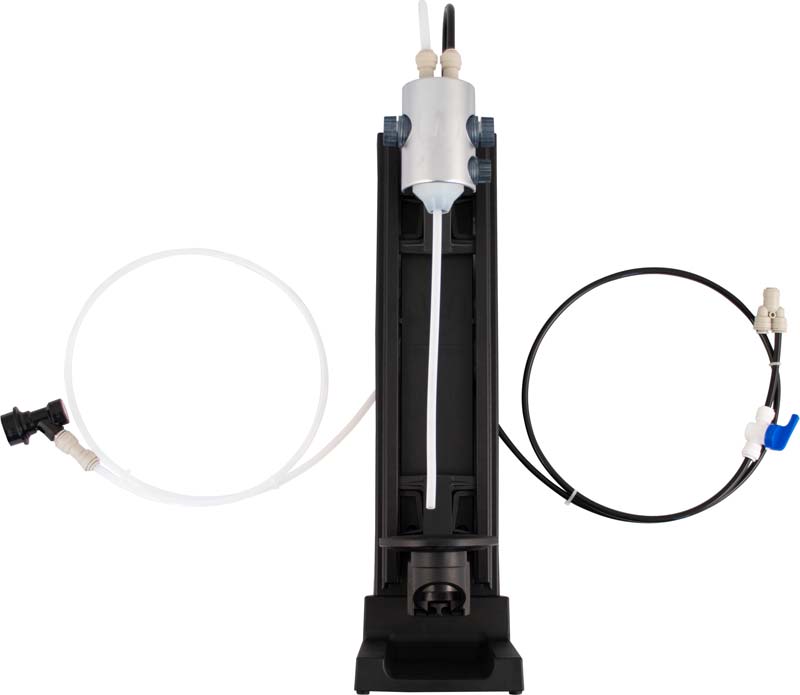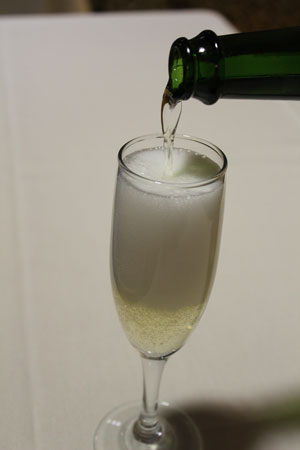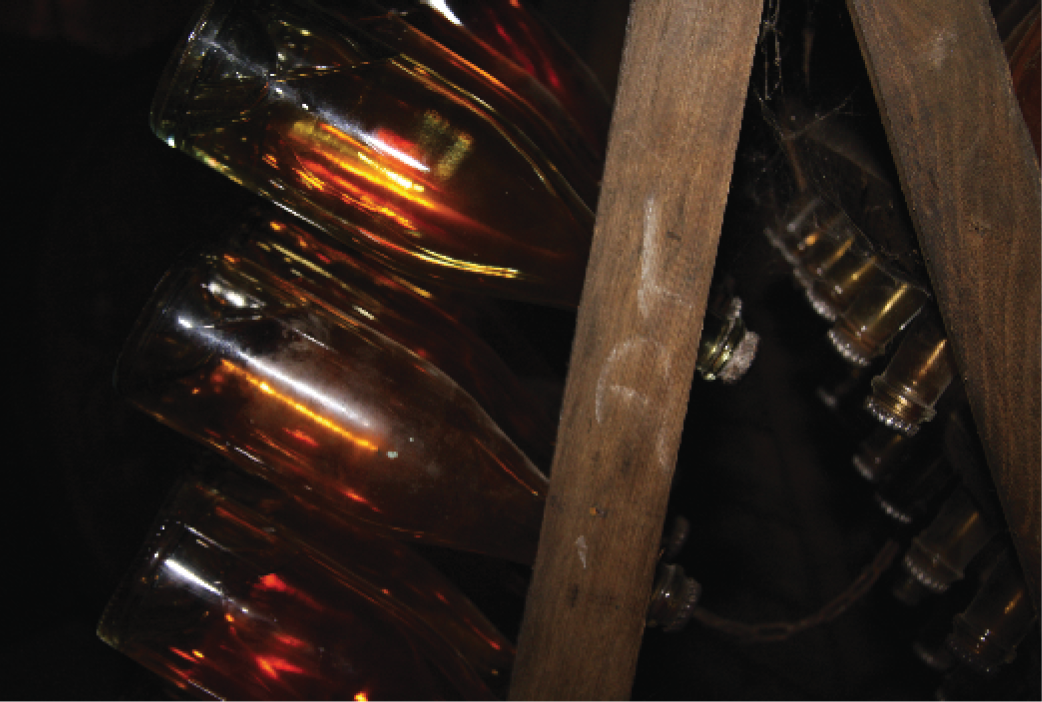No Trouble Bubbles

There are three fundamental methods to make sparkling wine at home. For pétillant naturel or pét-nat, all you need to do is put your newly fermented wine in a heavy pressure-resistant bottle before it is quite finished fermenting. If you do it right, you will get naturally sparkling wine that may also be cloudy. For méthode Champenoise, also known as méthode traditionnelle or the traditional method, you finish still, dry wine. Then you put it in heavy bottles, add some sugar and yeast, attach a crown cap, and let the wine ferment again to make the bubbles.
While you can chill it upright at that point and call it country sparkling wine, the full traditional method has you turn the bottles upside down for a few weeks, freeze the neck of the bottle in a brine bath, then remove the crown cap and allow the yeast-filled ice plug to blow out. Top up and sweeten what’s left, cork it, and you have clear, stable traditional sparkling wine. The third major method is today’s topic: Charmat or bulk process sparkling wine. (There are subcategories, variations, and synonyms for these methods, but three is enough for our purposes.)
For the Charmat process, as in the traditional method, a dry base wine — often blended and called a cuvée — is fermented first. Instead of bottles, though, it is placed in a stainless-steel pressure tank for the addition of sugar and yeast. Cool fermentation follows, developing pressure in the tank from carbon dioxide production. The finished carbonated wine is filtered under pressure and bottled under pressure, producing a sparkling wine with less hand labor than the traditional method. While less labor allows lower prices in the marketplace, Charmat sparkling wine can be excellent. Proseccos, for instance, are produced utilizing this method. With the right equipment and a bit of time, you can make Charmat sparkling wine at home.
To produce any sparkling wine, it is useful to review the pressure required. By comparison, draft beer is usually served at less than 15 pounds per square inch (psi) (~1 bar). Wine is called pétillant when it is pressurized to 15 to 36 psi (1 to 2.5 bar) under a carbon dioxide atmosphere. “Sparkling wine,” including Charmat and traditional method, is at higher pressure, greater than 44 psi or about three bars. For your Charmat sparkling wine you will need pressure-tolerant equipment that will work in these higher ranges.
For a complete Charmat process you will need two 5-gallon (19-L) stainless-steel soda syrup kegs, aka Corny kegs. These kegs (new and used) are readily available at homebrewing stores for dispensing homemade beer and wine. The kegs are usually rated to about 120 psi (8 bars), so quite safe at sparkling wine pressures. The kegs come in two styles known as pin-lock and ball-lock. Either will work, but you need to have all your accessories in the same style (I use exclusively ball-lock kegs). The terms refer to how the pressure attachments are secured to posts on the keg.
To pressurize your kegs, you will need a full CO2 cylinder equipped with a regulator that can deliver at least 60 psi (4 bars). You will also need a pressure gauge that is mounted on a fitting that can be attached to the gas (inlet) post of your keg, some thick-wall or reinforced vinyl tubing, and additional beverage and gas fittings for both kegs. You need a cartridge-style filter housing and a 0.45µ membrane filter cartridge.
For bottling your Charmat wine, you will need a device called a counter-pressure bottle filler that can be attached to your kegs, as well as heavy Champagne-style pressure bottles, a crown capper, and crown caps that fit your bottles. Instead of crown caps, you can alternatively use plastic Champagne stoppers fitted with wire cages to secure the stopper. To use cork stoppers you would need to buy or rent a Champagne floor corker (not the same as a standard floor corker) and Champagne corks with wire cages. Crown caps work well and are the easiest option.
Start with five gallons (19 L) of base wine — your cuvée. To resemble commercial sparkling wine, the blends tend to be higher in acidity and lower in alcohol content. While there are sparkling red wines, most are white or pink. Rack your wine to a sanitized Corny keg. Weigh out 20 to 25 g/L of table sugar or about 400 g total and boil it for one minute with about 400 mL of water to sanitize it. Stir the sugar into the wine and pitch a strong yeast like Lalvin EC1118, Prise de Mousse, at about two grams per gallon (0.5 g/L).
Close the keg, flush the headspace with carbon dioxide, disconnect your CO2 system, and attach your pressure gauge to the inlet (gas) post of the keg. Leave the out (beverage) fitting closed and disconnected. Place the keg in a cool location at 64 to 68 °F (18 to 20 °C). Warning: You are commencing fermentation in a sealed vessel and a dangerous rupture could occur! As fermentation begins, you will see the pressure rise on your gauge. If it exceeds 44 psi (3 bars), vent some gas by pulling the pressure relief on the keg lid. While the keg is safely rated for higher pressure, this should be high enough for a pleasant sparkling wine.
While your wine is undergoing its secondary fermentation, work on your dosage. The dosage level is the added sugar for a desired sweetness in your sparkling wine. Only the very, very driest of sparkling wines have no added sugar — they are typically called brut nature or zero dosage. More common are extra brut wines with about 6 g/L of sugar or brut with about 12 g/L. You can go sweeter with extra dry, sec, or even demi-sec with up to 50 g/L, according to your taste. Run some bench trials using a reserved portion of your base cuvée. Some sparkling wine producers add a small amount of brandy to their dosage as well. If that appeals to you, include brandy in your trials.
For a complete Charmat process you will need two 5-gallon (19-L) stainless-steel soda syrup kegs, aka Corny kegs.
When your fermenting keg holds steady at your desired pressure for at least two days, you may proceed to the filtration step. Replace your pressure gauge with a gas fitting from your CO2 regulator, set to the same pressure as your keg, but begin with the gas flow shut off. Sanitize your second keg and attach the outlet side of your filter to the outlet side of the keg — you want the wine to fill the keg from the bottom using what is ordinarily the dispensing dip tube. Boil the dosage sugar determined in your trials, cool, add brandy if using, and pour into the keg. Flush the keg with carbon dioxide and attach your pressure gauge to the gas post. Close and seal the lid.
Connect the “out” post of your full keg to the inlet side of the filter. Wine should flow immediately toward the second keg, due to the natural pressure in the first keg. Open your gas valve and push the wine through the filter. Vent gas from the second keg as needed to keep the wine flowing, but try not to lose your desired pressure. When all the wine has been transferred, disconnect all the fittings and chill the now full second keg for bottling.
There were probably yeast lees in the first keg that may clog the membrane filter. There are three things you can do to help. Before you start the project, you can remove the “out” post of your keg with a socket wrench, pull out the stainless steel dip tube, and use a hack saw to cut off ½ in. (1 cm) from the end. When re-installed, the tube will be just above the bottom of the keg and can leave the lees (and a small amount of wine) behind. Another step is to attach tubing with a plastic thumb tap to the keg before hooking up the filter. Open the tap over a waste bucket and run until the heaviest lees are out. Finally, you can filter from one keg to another through a coarse string-wound filter first, then clean everything and filter back through the membrane cartridge.
For bottling, a temperature near or slightly below 32 °F (0 °C) will help keep the gas dissolved in the wine and minimize excess foaming. Following the manufacturer’s instructions, connect your counter-pressure filler to the CO2 system and the full keg. Chill two cases of empty Champagne bottles. Use your filler to fill each bottle under pressure and quickly cap or cork.
A wing-type beer bottle capper is quick and easy. If you are using plastic corks, set the full bottle on a wooden block, begin inserting the cork, and drive it home with a rubber mallet. For Champagne corks and a Champagne floor corker, drop a cork between the jaws and set the full bottle on the platform. Pull down the arm, inserting the cork until a suitable mushroom-shaped head is left. Push the arm back up and pull the bottle down, freeing the cork through the hinged plate. For either plastic or cork stoppers, install a wire cage and give it six half-turns to hold the cork down. Wires are not needed for crown caps. Now fill another 23 bottles and you have two cases of Charmat sparkling wine! Chill and enjoy.
If that sounded like a lot of work, here is a simplification. It will not be fully Charmat style, but a very close approximation. Since we are home winemakers, we can do whatever we want, which in this case is force carbonation. For this process, you still need a CO2 tank and regulator. You only need one soda syrup keg and no filter. If you want to bottle, you still need a counter-pressure filler.

Once again, begin by making your cuvée. Do bench trials to plan your dosage by taste. Make the sugar syrup and add it to your sanitized keg. Rack in your still wine. If you will bottle the sparkling wine, add potassium sorbate stabilizer to prevent refermentation. Follow your supplier’s instructions, usually about one gram per gallon or 0.3 g/L. If you will keep your sparkling wine cold and dispense it on tap, you do not need the sorbate. The cold storage temperature will prevent fermentation.
Seal the keg and flush the headspace with CO2. Chill the keg. Attach the gas supply and set the regulator to your desired pressure. From time-to-time over the next few days, rock or agitate the keg to expedite mixing the gas into the liquid. To review systems and procedures you can use for draft sparkling wine, refer to the “Advanced Winemaking” column on kegging wine in the April-May 2023 issue.
If you want to bottle sparkling wine, the procedure uses the same counter-pressure system described above. The potassium sorbate takes the place of sterile filtration. Whether bottled or served on draft, your carbonated, slightly sweetened wine is a near relative of Charmat sparkling wine. You simply used industrial carbon dioxide instead of producing it in place through fermentation. The flavor might be slightly different, but I don’t think your guests will complain!






